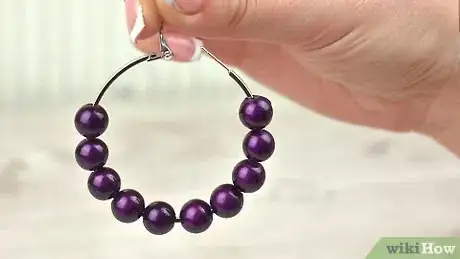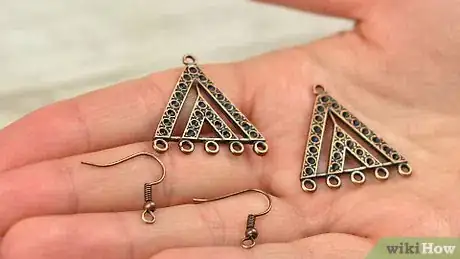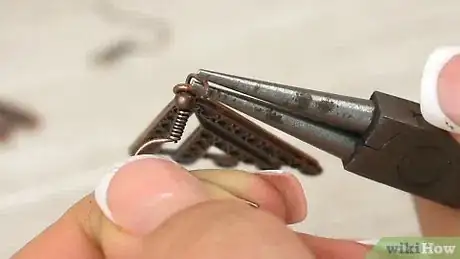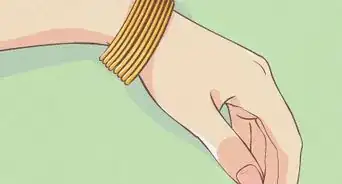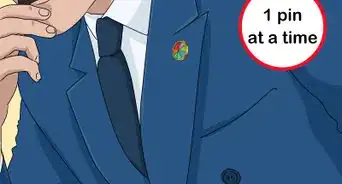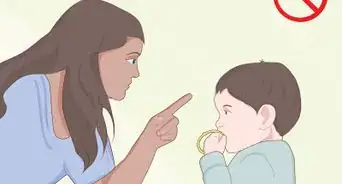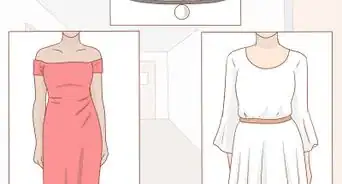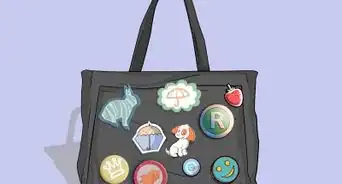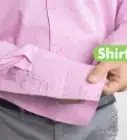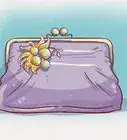This article was co-authored by wikiHow staff writer, Janice Tieperman. Janice is a professional and creative writer who has worked at wikiHow since 2019. With both a B.A. and M.A. in English from East Stroudsburg University, she has a passion for writing a wide variety of content for anyone and everyone. In her free time, you can find her working on a new crochet pattern, listening to true crime podcasts, or tackling a new creative writing project.
There are 7 references cited in this article, which can be found at the bottom of the page.
The wikiHow Video Team also followed the article's instructions and verified that they work.
This article has been viewed 30,238 times.
Learn more...
If you’re making or repairing an earring, you’ll need a functioning earring hook to get the job done. When working with non-hoop earrings, use a pair of round- or needle-nosed pliers to open and close the small metal loop attached to the earring hook. If you’re working with hoop earrings, you can use your hands to open and close the earring. Once you get the hang of opening and closing these loops or hoops, you can try adding premade earrings to your hooks!
Steps
Opening and Closing the Earring Hook
-
1Use pliers to pull on 1 end of the bottom loop if you have a French earring hook. Examine the bottom end of your French earring hook to find a small metal loop attached. Next, pinch the loose, disconnected end of the wire with a pair of round- or needle-nosed pliers. Pull upwards or outwards on the end of the loop to create a wide gap, which you can use to string on beads or other jewelry attachments.[1]
- French earring hooks have a gentle curve, and are commonly used in a variety of handmade jewelry. Some varieties of this hook have a wire coil attached to the base.
- You can use this open loop to attach other earring decorations, like feathers or dangling leather shapes.
- You can use the same process to open the small metal loops attached to lever-back French clips and earring posts. As the name suggests, lever-back hooks use a clasping mechanism to secure the earring, while posts use a straight strand, or “post,” of metal.[2]
-
2Unfasten the clasp if you’re working with a kidney wire. Examine the bottom portion of a kidney wire and find a fastener securing a loose section of wire into place. Use your fingers to pull the loose section of wire away from the fastener so you can string beads or jewelry attachments onto the hook.[3]
- As the name suggests, kidney wires are ovular hooks that form complete loops, and have a clasp that prevents the actual earring from sliding off.
- You can string beads onto kidney wire hooks while also attaching other earring accessories to the bottom loop.
Advertisement -
3Unclip or unfasten the connecting wire if you have a hoop earring. Examine your specific set of hoop earrings to see what kind of mechanism holds it together. Pull, twist, or unfasten the loose end of wire to open the earring hook, which allows you to string beads and other trinkets onto the hoop. Note that, unlike other earrings, hoops double as both the hook and the earring itself.[4]
- Manipulating hoops have a flattened metal end with a hole drilled in the center where the loose section of wire threads through. To connect and disconnect the hoop, slide the loose section of wire through the drilled hole.
- Leverback hoops use a clasp mechanism, which can be opened and closed to secure the earring.
- Crimp hoops use a special clip to hold the hoop together. To secure the earring into place, pull down the lever that’s attached to the crimp.
- Endless hoops are made with a curved, hollow loop that accepts and secures a thin, small section of wire. Stick the thin portion of wire into the hollow loop to secure the jewelry, then pull on the wire to open the hoop.
- Sleeper hoops come with a twisting mechanism that locks the loose section of wire into place.
-
4String beads onto earring hoops or kidney wires to add a decorative touch. Take the beads of your choice and thread them onto the thin, loose section of wire. Next, drag the beads down the length or curve of the wire until you’re happy with their placement. To create a fun pattern or colorful effect, string additional beads onto the hoop or kidney wire.[5]
- This type of design only works with kidney wires or hoops, as both earring hooks create continuous loops.
-
5Use pliers to tighten and close the small loop attached to the hook. Once your desired beads and decorations are threading onto the earring hook, you can pinch the loose, open end of the earring hook with a round- or needle-nosed set of pliers. Push the wire back to its original position, completing the original loop and securing the earring in place.[6]
- Double-check that the earring is secure before trying it on.
- This process doesn’t apply to any kind of hoop earring.
Attaching Premade Earrings to a Hook
-
1Select a pair of premade earrings that match your earring hooks. Search online or in your local craft store for a set of premade earrings. If you’re purchasing metallic earrings, check that the earring is similar in color to the hooks that you have on hand. If you’re purchasing colorful, non-metallic earrings, then you don’t have to worry about this.[7]
- For instance, if you have a pair of silver earring hooks, you’d want to pick out a pair of silver premade earrings.
-
2Use pliers to open the bottom loop attached to the hook. Pinch the end of this loop with a pair of round- or needle-nosed pliers, then pull upwards or outwards. Open the loop to create a 4mm-wide gap, so you can thread premade earrings onto the hook. If you’re having trouble opening the loop, try using another set of pliers to hold the earring hook in place.[8]
- For instance, you could use the pliers in your left hand to hold the hook in place, and the pliers in your right hand to open the loop.
-
3Slide any premade earring onto the loop attached to the earring hook. Find the metal loop that’s attached to your earring of choice and thread it onto the earring hook’s open loop. At this point, check that the entire earring is intact so it won’t fall or slip off.[9]
-
4Secure the earring by closing the metal loop with pliers. Arrange the open loop between the teeth of the pliers, then squeeze the pliers together. Next, apply an even amount of force so the loop closes completely. Continue squeezing this loop until it’s completely shut, and the earring is securely attached to the hook.[10]
- If you want, try shaking the earring a little bit to ensure that hook is secure.
Things You’ll Need
- Round- or needle-nose pliers
References
- ↑ https://www.youtube.com/watch?v=CCjTAVbUwZk&t=1m27s
- ↑ https://www.rings-things.com/Designer%20Tip%20Sheets/Making%20earrings.pdf
- ↑ https://www.youtube.com/watch?v=Bf-HomaZVzA&t=1m3s
- ↑ https://www.rings-things.com/Designer%20Tip%20Sheets/Making%20earrings.pdf
- ↑ https://www.rings-things.com/Designer%20Tip%20Sheets/Making%20earrings.pdf
- ↑ https://www.youtube.com/watch?v=CCjTAVbUwZk&t=1m40s
- ↑ https://www.youtube.com/watch?v=keJ-J9MMIXU&t=1m25s
- ↑ https://www.youtube.com/watch?v=0krpzuj0s5k&t=0m5s
- ↑ https://www.rings-things.com/Designer%20Tip%20Sheets/Making%20earrings.pdf

